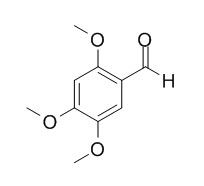2,4,5-Trimethoxybenzaldehyde
2,4,5-Trimethoxybenzaldehyde (2,4,5-TMBA) has anti-adipogenic potential, is a natural cyclooxygenase II (COX-2) inhibitor, suppresses the differentiation of preadipocyts into adipocytes at the concentration of 0.5 mM.
Inquire / Order:
manager@chemfaces.com
Technical Inquiries:
service@chemfaces.com
Tel:
+86-27-84237783
Fax:
+86-27-84254680
Address:
1 Building, No. 83, CheCheng Rd., Wuhan Economic and Technological Development Zone, Wuhan, Hubei 430056, PRC
Providing storage is as stated on the product vial and the vial is kept tightly sealed, the product can be stored for up to
24 months(2-8C).
Wherever possible, you should prepare and use solutions on the same day. However, if you need to make up stock solutions in advance, we recommend that you store the solution as aliquots in tightly sealed vials at -20C. Generally, these will be useable for up to two weeks. Before use, and prior to opening the vial we recommend that you allow your product to equilibrate to room temperature for at least 1 hour.
Need more advice on solubility, usage and handling? Please email to: service@chemfaces.com
The packaging of the product may have turned upside down during transportation, resulting in the natural compounds adhering to the neck or cap of the vial. take the vial out of its packaging and gently shake to let the compounds fall to the bottom of the vial. for liquid products, centrifuge at 200-500 RPM to gather the liquid at the bottom of the vial. try to avoid loss or contamination during handling.
Anticancer Res.2021, 41(3):1357-1364.
J of l. Chroma.&Related Tech2020, 43(11-12):414-423.
Am J Chin Med.2016, 44(8):1719-1735
Biochem Biophys Res Commun.2021, 534:802-807.
BMC Complement Altern Med.2014, 14:352
Front Plant Sci.2021, 12:673337.
Synthetic and Systems Biotechnology2023, j.synbio.
Food Chem.2024, 446:138870.
Metabolites.2020, 10(11):440.
Mol Med Rep.2024, 29(2):26.
Related and Featured Products
J Agric Food Chem. 2014 Oct 8;62(40):9860-7.
2,4,5-trimethoxybenzaldehyde, a bitter principle in plants, suppresses adipogenesis through the regulation of ERK1.[Pubmed:
25222709 ]
We demonstrated that 2,4,5-Trimethoxybenzaldehyde (2,4,5-TMBA), a bitter principle in plants and a natural cyclooxygenase II (COX-2) inhibitor, suppressed the differentiation of preadipocyts into adipocytes at the concentration of 0.5 mM.
METHODS AND RESULTS:
In this current study, we aimed to investigate the stage during adipogenesis that is critically affected by 2,4,5-Trimethoxybenzaldehyde and the effects of 2,4,5-Trimethoxybenzaldehyde on the time-course expression of signaling molecules MAP kinase kinase (MAPKK, represented by MEK) and extracellular signal-regulated kinase (ERK), transcription factors CCAAT/enhancer binding protein (C/EBP)α, β, and δ and peroxisome proliferator-activated receptor (PPAR)γ, lipogenic enzymes acetyl-CoA carboxylase (ACC) and fatty acid synthase (FAS), and lipid droplet-coating protein perilipin A. When preadipocytes were co-cultured with 2,4,5-Trimethoxybenzaldehyde (0.5 mM) specifically at post-induction days 0-2, 2-4, 4-6, or 6-8 only, relative lipid accumulation was decreased by 67.93, 34.65, 49.56, and 34.32%, respectively. A time-course study showed that treatment of 2,4,5-Trimethoxybenzaldehyde suppressed the phosphorylation of ERK1 at the initial stage of adipogenesis but upregulated the phosphorylation at the late stage, which is opposite to the conditions required for the differentiation process. The overall expression of C/EBPα, β, and δ, PPARγ2, ACC, FAS, and perilipin A in preadipocytes was downregulated by the treatment of 2,4,5-Trimethoxybenzaldehyde.
METHODS AND RESULTS:
Taken together, our findings suggest that 2,4,5-Trimethoxybenzaldehyde suppresses adipogenesis through the regulation of ERK1 phosphorylation. Although results from in vitro studies cannot be directly extrapolated into clinical effects, our study will help to elucidate the anti-adipogenic potential of 2,4,5-Trimethoxybenzaldehyde.
Lett Appl Microbiol. 2007 Apr;44(4):387-92.
Production of a COX-2 inhibitor, 2,4,5-trimethoxybenzaldehyde, with submerged cultured Antrodia camphorata.[Pubmed:
17397476]
To investigate the active ingredient in fruiting bodies and to produce it with cultured mycelium in Antrodia camphorata (BCRC 35398).
METHODS AND RESULTS:
The volatile components from the fruiting bodies, the liquid cultured broth of A. camphorata and Cinnamomum kanehirae wood were separately isolated by steam distillation-solvent extraction and identified by gas chromatography-mass spectrometry. In the fruiting bodies, a COX-2 inhibitor 2,4,5-Trimethoxybenzaldehyde (TMBA) was found to be the most abundant constituent, but was totally absent in its cultured broth and its natural host, C. kanehirae wood. On feeding with the acid-digested sawdust of C. kanehirae wood or vanillin to the broth for culture, TMBA was produced in both cultured broths.
CONCLUSIONS:
The TMBA identified in fruiting bodies was an active ingredient whose functions consisted with the reported experiences of this mushroom. Feeding vanillin to culture broth could produce TMBA containing mycelium product like its fruiting bodies did.
This study found an active ingredient in fruiting bodies of A. camphorata and elucidated this compound derived from digested sawdust of C. kanehirae wood. A feasible method was also developed to produce TMBA containing mycelium by feeding vanillin.



